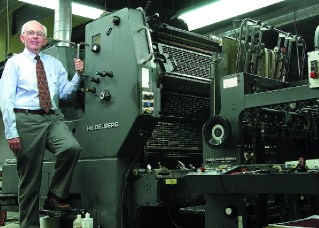Harvard has gotten out of the printing business for the third time in its history. On June 17 the University shed the 23 workers composing the offset-printing production staff of Harvard Printing and Publication Services (HPPS), effective immediately, and shut down its once-celebrated printing operation.
 |
| University printer Daniel J. McCarron with a now-silent two-color Heidelberg press. During his 25 years at Harvard, McCarron has acted, in effect, as a publications consultant for hundreds of University print buyers. |
| Photograph by Stu Rosner |
In 1998, in what may now be seen as the beginning of the end, HPPS offered a buyout package to 100 eligible staff, and 80 took it. After some necessary subsequent new hiring, the entire enterprise was down to between 50 and 60 people before the recent departures. HPPS sold its larger presses, retaining only machines suitable to print letterhead and other small-scale jobs and turning to outside suppliers on behalf of customers when needs dictated.
The enterprise had since "continued to lose money in an intensely competitive business climate," says Daniel J. McCarron, whose official title is University printer, but whose card describes him more usefully as "client manager/senior design consultant." "Many large competitors and industry mergers have made it difficult for us to compete," says Susan S. Walsh of University Information Systems, which oversees HPPS.
HPPS will maintain a small staff to run its Docutech machines and mail services. Docutechs are all-digital affairs that McCarron describes as "very sophisticated copying equipment." Harvard produces its diplomas handsomely on these machines, the Business School copies on demand a case for class use, the College admissions office generates personalized acceptance and rejection letters, and so on. But University people still have abundant demand for traditional printing services.
Harvard spends $45 million a year on print, doing business with more than 160 outside vendors, says William G. Hoyt, director for procurement. He thinks the number of vendors might better be reduced to 10 to 20. The number of Harvard print buyers is so far unknown, but they are decentralized and numerous.
In action unrelated to the decision to take Harvard out of the printing business, Hoyt and a study committee he chairs, composed of Harvard people who buy different kinds of printing, are in the process of soliciting bids from suppliers and selecting a small number of them to be designated "certified University vendor partners." "We aim to aggregate the University's demand," says Hoyt, "expecting to obtain lower prices and a higher level of service." University buyers are not obligated to use certified vendors, but Hoyt supposes that if the system works as it shouldand as it has with other commodities Harvard buys a lot of, such as office furniture, lab supplies, and bottled waterUniversity customers will willingingly patronize the chosen few.
Meanwhile, back at the old shop, McCarron will stay on at HPPS during a transition period to oversee the sale of equipment and to wind up outstanding work for clients by using outside vendors. He winds up more than that; he puts the period at the end of a long history.
In 1640 Harvard's first president, Henry Dunster, married the widow Elizabeth Glover, who owned the first printing press in British North America. Her establishment produced a freeman's oath, an almanac, and a bestseller known popularly as the "Bay Psalm Book" before she died in 1643. Her press, type, and paper passed to the president, and Harvard got into the business. Five presidents later, in 1692, the Corporation dispersed its printing equipment and for more than a century afterwards, sent work out.
In his book Harvard University Press: A Historyabout the publishing organization Max Hall writes that because Boston printers were enjoying a mini boom printing textbooks generated by Harvard faculty members, the Corporation in 1802 voted to establish a new manufacturing facility to be called the "University Press." But during a spell of financial hard times 25 years later, the ink turned red and the Corporation sold the establishment.
The University's third venture into printing began in 1872 and sprang, according to Hall, from dissatisfaction over prices charged by commercial printers and suspicion of skulduggery among them in leaking to students the questions on examinations sent out to be printed. Now in large quarters in Allston, from 1913 to 1942 the enterprise was the printing department of publisher Harvard University Press. The 1920s were the plant's golden age. Preeminent typographers and designers were in and out of the shop or actually on staff, among them Daniel Berkeley Updike, W.A. Dwiggins, and Bruce Rogers, once called "the greatest artificer of the book who ever lived."
R.I.P., Harvard printing office.








